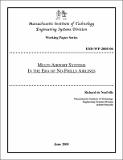Multi-Airport Systems in the Era of No-Frills Airlines
Author(s)
de Neufville, Richard
Downloadesd-wp-2005-06.pdf (104.3Kb)
Metadata
Show full item recordAbstract
The development of no-frills airlines is promoting a remarkable expansion in the number of secondary airports in major metropolitan areas. These new carriers are creating a significant alternative to the traditional full-service carriers. In effect, they are establishing a parallel market and corresponding network of airports. This conclusion results from the analysis of a worldwide database on major metropolitan airports.
This effect supplements the "number of originating passengers", that has been the traditional significant factor that promotes the establishment of viable multi-airport systems. This factor maintains its importance, but no longer is as decisive as it has been.
Airlines and airport policies further reinforce the independent network of secondary airports. Nofrills airlines that sell only through the web to customers effectively cause their services at secondary airports to disappear from the airline reservation systems. Airports that choose not to provide low-cost service to no-frills airlines likewise strengthen the role of the secondary airports. Such strategies, most visible in Europe, have led to a remarkable proliferation of secondary airports in unexpected areas.
This trend implies a traffic shift away from the expensive, congested airports toward the no-frills, inexpensive and uncongested airports in major metropolitan areas. If the current major airlines do shrink substantially, as could happen, this would greatly change the pattern of airport traffic in major metropolitan areas.
Date issued
2005-06Publisher
Massachusetts Institute of Technology. Engineering Systems Division
Series/Report no.
ESD Working Papers;ESD-WP-2005-06